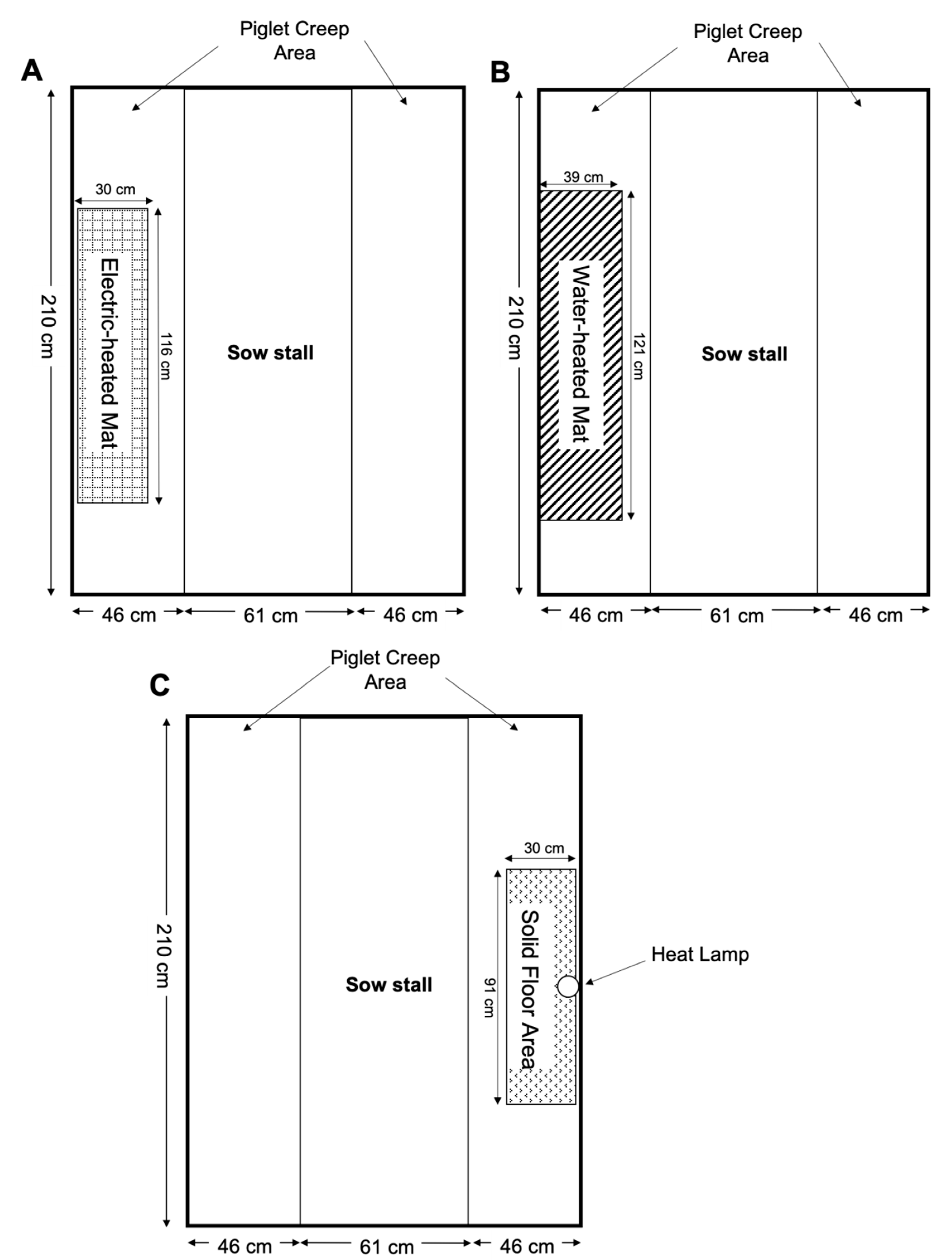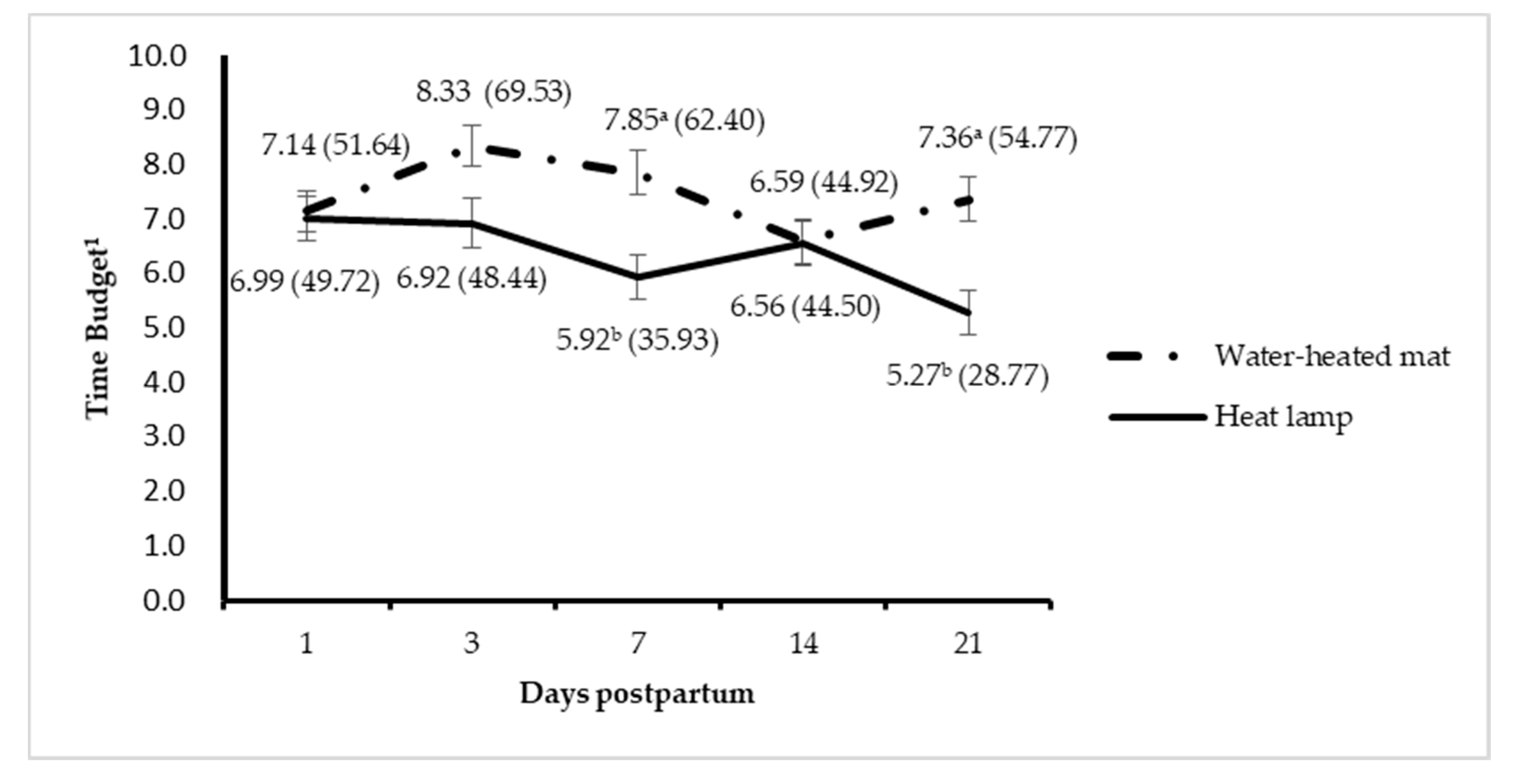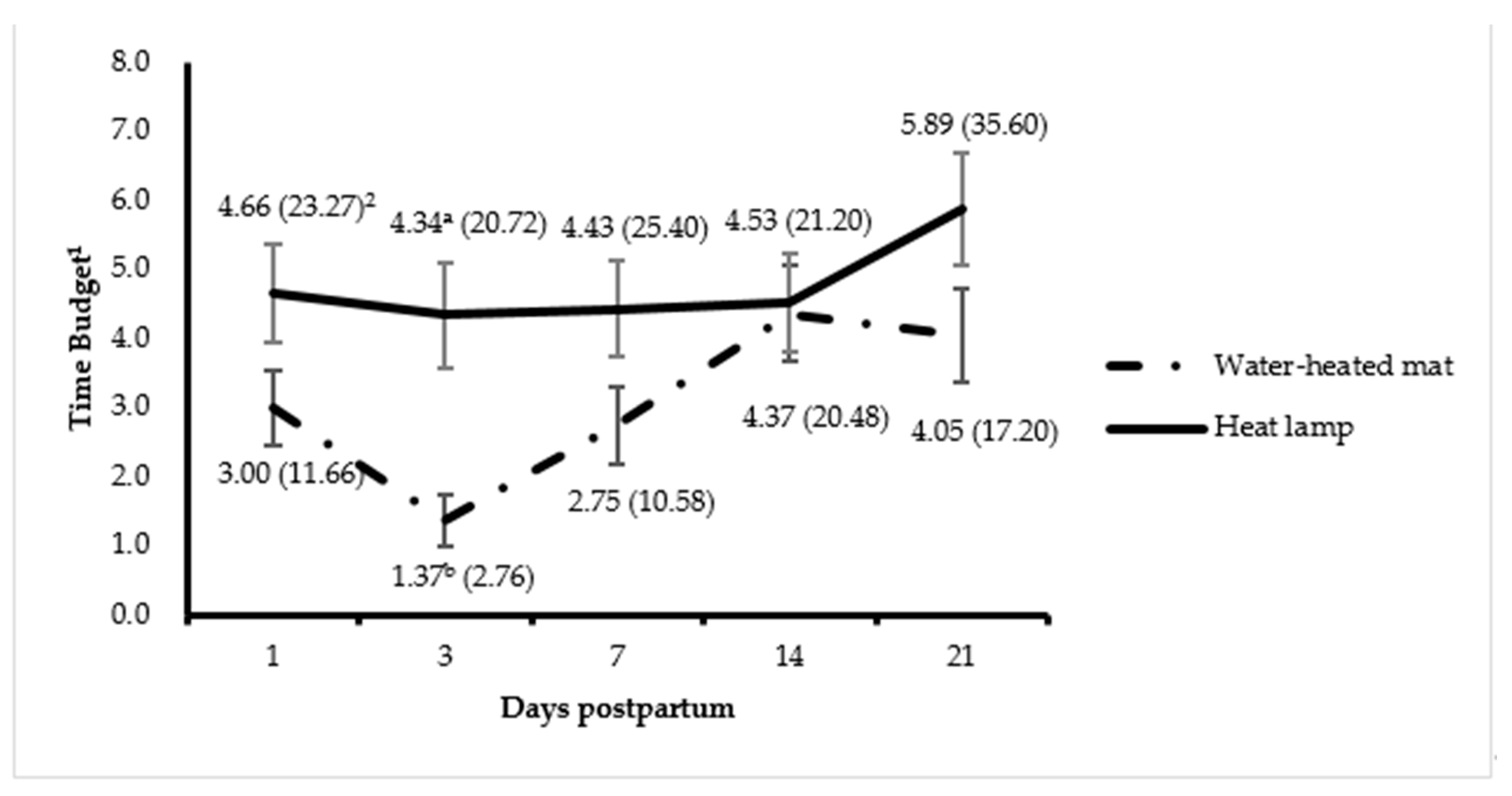Behavior and Performance of Suckling Piglets Provided Three Supplemental Heat Sources
Abstract
:Simple Summary
Abstract
1. Introduction
2. Materials and Methods
2.1. Animals, Housing, and Management
2.2. Heat Sources for Piglets
2.3. Experimental Design
2.4. Data Collection
2.4.1. Behavior of Piglets
2.4.2. Performance of Piglets
2.5. Data Analysis
3. Results
3.1. Trial 1: Comparing the Effect of Water-Heated Mat and Heat Lamp on Piglet Performance and Behavior
3.2. Trial 2: Comparing the Effect of Electric-Heated Mat and Heat Lamp on Piglet Performance and Behavior
3.3. Trial 3: Comparing the Effect of Water-Heated Mat and Electric-Heated Mat on Piglet Performance and Behavior
4. Discussion
5. Conclusions
Author Contributions
Funding
Acknowledgments
Conflicts of Interest
References
- Mount, L.E. Environmental Temperature Preferred by the Young Pig. Nature 1963, 199, 1212–1213. [Google Scholar] [CrossRef] [PubMed]
- Quiniou, N.; Noblet, J. Influence of High Ambient Temperatures on Performance of Multiparous Lactating Sows. J. Anim. Sci. 1999, 77, 2124–2134. [Google Scholar] [CrossRef] [PubMed]
- Adams, K.L.; Baker, T.H.; Jensen, A.H. Effect of Supplemental Heat for Nursing Piglets. J. Anim. Sci. 1980, 50, 779–782. [Google Scholar] [CrossRef] [PubMed] [Green Version]
- Kirkden, R.D.; Broom, D.M.; Andersen, I.L. Invited Review: Piglet Mortality: Management Solutions. J. Anim. Sci. 2013, 91, 3361–3389. [Google Scholar] [CrossRef]
- Kammersgaard, T.S.; Pedersen, L.J.; Jorgensen, E. Hypothermia in Neonatal Piglets: Interactions and Causes of Individual Differences. J. Anim. Sci. 2011, 89, 2073–2085. [Google Scholar] [CrossRef]
- Andersen, I.L.; Haukvik, I.A.; Boe, K.E. Drying and Warming Immediately after Birth May Reduce Piglet Mortality in Loose-Housed Sows. Animal 2009, 3, 592–597. [Google Scholar] [CrossRef] [Green Version]
- McGinnis, R.M.; Marple, D.N.; Ganjam, V.K.; Prince, T.J.; Pritchett, J.F. The Effects of Floor Temperature, Supplemental Heat and Drying at Birth on Neonatal Swine. J. Anim. Sci. 1981, 53, 1424–1432. [Google Scholar] [CrossRef] [Green Version]
- Malmkvist, J.; Pedersen, L.J.; Damgaard, B.M.; Thodberg, K.; Jørgensen, E.; Labouriau, R. Does Floor Heating around Parturition Affect the Vitality of Piglets Born to Loose Housed Sows? Appl. Anim. Behav. Sci. 2006, 99, 88–105. [Google Scholar] [CrossRef]
- Pedersen, L.J.; Larsen, M.L.; Malmkvist, J. The Ability of Different Thermal Aids to Reduce Hypothermia in Neonatal Piglets. J. Anim. Sci. 2016, 94, 2151–2159. [Google Scholar] [CrossRef] [PubMed]
- Lane, K. Heat Lamps and Heat Mats in the Farrowing House: Effect on Piglet Production, Piglet and Sow Behavior and Energy Usage. Master’s Thesis, Iowa State University, Ames, IA, USA, 2019. [Google Scholar]
- Larsen, M.L.V.; Thodberg, K.; Pedersen, L.J. Radiant Heat Increases Piglets’ Use of the Heated Creep Area on the Critical Days after Birth. Livest. Sci. 2017, 201, 74–77. [Google Scholar] [CrossRef] [Green Version]
- Xin, H.; Zhou, H.; Bundy, D.S. Heat Lamp Usage by Neonatal Piglets. Anim. Ind. Rep. 1997, 1, 95–99. [Google Scholar]
- Davis, J.D.; Xin, H.; MacDonald, R.D. Infrared Thermographic Evaluation of Commercially Available Incandescent Heat Lamps. Appl. Eng. Agric. 2008, 24, 685–693. [Google Scholar] [CrossRef]
- Johnston, L.J.; Sharpe, K.T.; Reese, M.H.; Buchanan, E.S.; Tallaksen, J.E.; Hilbrands, A.M.; Janni, K.A.; Hetchler, B.; Li, Y. Quantifying Use of Electricity to Heat Piglet Creep Areas in Farrowing Rooms. Adv. Anim. Biosci. 2019, 10, s22. [Google Scholar]
- Sharpe, K.T.; Reese, M.H.; Buchanan, E.S.; Tallaksen, J.E.; Janni, K.A.; Johnston, L.J. Electrical and Thermal Energy Consumption in Midwest Commercial Swine Facilities. Appl. Eng. Agric. 2018, 34, 857–864. [Google Scholar] [CrossRef]
- NRC. Nutrient Requirements of Swine, 11th ed.; Natl. Acad. Press: Washington, DC, USA, 2012. [Google Scholar] [CrossRef] [Green Version]
- Li, Y.; Lou, M.; Reese, M.; Buchanan, E.; Johnston, L.J. Effects of Cooled Floor Pads and Cooled Drinking Water on Behavior of Lactating Sows under Heat Stress. J. Anim. Sci. 2019, 97 (Suppl. 2), 2–3. [Google Scholar] [CrossRef]
- Martin, P.; Bateson, P. Measuring Behavior: An Introductory Guide, 2nd ed.; Cambridge University Press: New York, NY, USA, 2007; pp. 84–100. [Google Scholar] [CrossRef]
- He, Y.; Deen, J.; Shurson, G.C.; Li, Y.Z. Behavioral Indicators of Slow Growth in Nursery Pigs. J. Appl. Anim. Welf. Sci. 2018, 21, 389–399. [Google Scholar] [CrossRef]
- SAS Institute Inc. Base SAS 9.4 Procedures Guide: Statistical Procedures, 2nd ed.; Statistical Analysis System Institute Inc.: Cary, NC, USA, 2013. [Google Scholar]
- Zhang, Q.; Xin, H. Responses of Piglets to Creep Heat Type and Location in Farrowing Crate. Appl. Eng. Agric. 2001, 17, 515–519. [Google Scholar] [CrossRef]
- The Pig Site. Pig Heating Pads vs. Heat Lamps—The Importance of Proper Heat Placement in Farrowing Facilities. Available online: https://thepigsite.com/articles/pig-heating-pads-vs-heat-lamps (accessed on 22 May 2020).
- Fengdan, L.; Brown-Brandl, T.M.; Stinn, J.P.; Teng, G.; Liu, K.; Xin, H. Sow Lying Behaviors before, During and after Farrowing. In ASABE Annual International Meeting; American Society of Agricultural and Biological Engineers: St. Joseph, MI, USA, 2016; p. 1. [Google Scholar]
- Stinn, J.P.; Xin, H. Heat Lamp vs. Heat Mat as Localized Heat Source in Swine Farrowing Crate. Anim. Ind. Rep. 2014, 660, 96. [Google Scholar]
- Beshada, E.; Zhang, Q.; Boris, R. A Cost Effective Heating Method for Piglets in Swine Farrowing Barns. In ASABE Annual International Meeting; American Society of Agricultural and Biological Engineers: St. Joseph, MI, USA, 2016; p. 1. [Google Scholar]
- Muns, R.; Nuntapaitoon, M.; Tummaruk, P. Non-Infectious Causes of Pre-Weaning Mortality in Piglets. Livest. Sci. 2016. 184, 46–57. [CrossRef]
- Zeng, Z.K.; Urriola, P.E.; Dunkelberger, J.R.; Eggert, J.M.; Vogelzang, R.; Shurson, G.C.; Johnston, L.J. Implications of Early-Life Indicators for Survival Rate, Subsequent Growth Performance, and Carcass Characteristics of Commercial Pigs. J. Anim. Sci. 2019, 97, 3313–3325. [Google Scholar] [CrossRef]
- Nuntapaitoon, M.; Muns, R.; Tummaruk, P. Newborn Traits Associated with Pre-Weaning Growth and Survival in Piglets. Asian-Aust. J. Anim. Sci. 2018, 31, 237–244. [Google Scholar] [CrossRef] [PubMed]
- Beaulieu, A.D.; Aalhus, J.L.; Williams, N.H.; Patience, J.F. Impact of Piglet Birth Weight, Birth Order, and Litter Size on Subsequent Growth Performance, Carcass Quality, Muscle Composition, and Eating Quality of Pork. J. Anim. Sci. 2010, 88, 2767–2778. [Google Scholar] [CrossRef]
- Ziron, M.; Hoy, S. Effect of a Warm and Flexible Piglet Nest Heating System—The Warm Water Bed—On Piglet Behaviour, Live Weight Management and Skin Lesions. Appl. Anim. Behav. Sci. 2003, 80, 9–18. [Google Scholar] [CrossRef]
- Xin, H.; Zhou, H.; Bundy, D.S. Comparison of Energy Use and Piglet Performance between Conventional and Energy-Efficient Heat Lamps. Appl. Eng. Agric. 1997, 13, 95–99. [Google Scholar] [CrossRef]
- Berg, S.; Andersen, I.L.; Tajet, G.M.; Haukvik, I.A.; Kongsrud, S.; Boe, K.E. Piglet Use of the Creep Area and Piglet Mortality—Effects of Closing the Piglets inside the Creep Area During Sow Feeding Time in Pens for Individually Loose-Housed Sows. Anim. Sci. 2006, 82, 277–281. [Google Scholar] [CrossRef]
- Petherick, J.C.; Phillips, C.J.C. Space Allowances for Confined Livestock and Their Determination from Allometric Principles. Appl. Anim. Behav. Sci. 2009, 117, 1–12. [Google Scholar] [CrossRef]



| Item | Treatment | Pooled SE | p-Value | |||
|---|---|---|---|---|---|---|
| Water-Heated Mat | Heat Lamp | Treatment | Day | Interaction | ||
| # of sows | 7 | 6 | - | - | - | - |
| Sow Parity | 3.7 | 4.5 | 0.43 | 0.20 | - | - |
| Litter size, piglets/litter | ||||||
| Born alive | 14.7 | 13.9 | 1.22 | 0.63 | - | - |
| After cross-fostering 1 | 14.1 | 13.4 | 0.42 | 0.18 | - | - |
| Dead 2 | 3.3 | 1.1 | 0.94 | 0.053 | - | - |
| At weaning 3 | 10.8 | 12.3 | 0.81 | 0.23 | - | - |
| Mortality 4,% | 22.9 | 8.9 | 7.63 | 0.06 | - | - |
| Litter weight, kg | ||||||
| At birth 5 | 18.1 | 19.5 | 1.63 | 0.56 | - | - |
| At weaning 3 | 60.5 | 73.5 | 5.20 | 0.10 | - | - |
| Average piglet weight, kg | ||||||
| At birth 5 | 1.2 | 1.5 | 0.10 | 0.11 | - | - |
| At weaning 3 | 5.5 | 6.1 | 0.30 | 0.22 | - | - |
| Average daily litter gain 6, kg | 2.4 | 3.0 | 0.19 | 0.054 | - | - |
| Average daily piglet gain 6, g | 224.7 | 242.9 | 10.40 | 0.21 | - | - |
| Behavioral time budget 7,% | ||||||
| Lying on mats or under heat lamps | 7.5 (56.0) 8 | 6.3 (40.6) | 0.19 | 0.001 | 0.03 | 0.03 |
| Standing on mats or under heat lamps | 3.3 (11.3) | 3.1 (10.0) | 0.14 | 0.28 | 0.07 | 0.81 |
| Total time spent on mats or under heat lamps | 8.2 (67.5) | 7.1 (51.0) | 0.19 | 0.002 | 0.01 | 0.11 |
| Lying away from mats or heat lamps | 2.9 (10.4) | 4.7 (24.7) | 0.33 | 0.001 | 0.01 | 0.10 |
| Standing away from mats or heat lamps | 4.3 (19.0) | 4.7 (22.3) | 0.17 | 0.09 | 0.11 | 0.12 |
| % of total mat area covered by piglets | 6.6 (43.7) | 6.9 (48.9) | 0.18 | 0.23 | 0.19 | 0.05 |
| Item | Day after Birth | Pooled SE | ||||
|---|---|---|---|---|---|---|
| 1 | 3 | 7 | 14 | 21 | ||
| Behavioral time budget 1, % | ||||||
| Lying on mats or under heat lamps | 7.1 ab (50.7) 2 | 7.6 ae (58.0) | 6.9 ab (39.7) | 6.6 abf (44.7) | 6.3 b (39.7) | 0.2922 |
| Standing on mats or under heat lamps | 3.4 ab (12.3) | 3.4 ab (11.7) | 3.5 a (13.7) | 3.0 ab (9.6) | 2.7 b (7.3) | 0.2248 |
| Total time spent on mats or under heat lamps | 7.9 ab (62.9) | 8.4 a (69.8) | 7.8 ab (61.9) | 7.3 ab (54.4) | 6.9 b (41.1) | 0.3035 |
| Lying away from mats or heat lamps | 3.7 ae (16.5) | 2.4 bg (7.6) | 3.5 abf (16.4) | 4.5 a (20.8) | 4.9 ae (24.8) | 0.5272 |
| Item | Treatment | Pooled SE | p-Value | |||
|---|---|---|---|---|---|---|
| Electric-Heated mat | Heat Lamp | Treatment | Day | Interaction | ||
| # of sows | 8 | 8 | - | - | - | - |
| Sow Parity | 2.9 | 2.5 | 0.59 | 0.65 | - | - |
| Litter size, piglets/litter | ||||||
| Born alive | 13.6 | 13.3 | 1.47 | 0.86 | - | - |
| After cross-fostering 1 | 13.6 | 12.9 | 0.88 | 0.55 | - | - |
| Dead 2 | 1.6 | 1.8 | 0.81 | 0.91 | - | - |
| At weaning 3 | 12.0 | 11.1 | 0.67 | 0.37 | - | - |
| Mortality 4, % | 10.7 | 9.9 | 4.73 | 0.90 | - | - |
| Litter weight, kg | ||||||
| At birth 5 | 20.0 | 19.8 | 1.71 | 0.92 | - | - |
| At weaning 3 | 77.0 | 75.3 | 4.97 | 0.81 | - | - |
| Average piglet weight, kg | ||||||
| At birth 5 | 1.5 | 1.6 | 0.11 | 0.61 | - | - |
| At weaning 3 | 6.5 | 6.8 | 0.29 | 0.48 | - | - |
| Average daily litter gain 6, kg | 3.1 | 2.9 | 0.20 | 0.53 | - | - |
| Average daily piglet gain 6, g | 258.2 | 261.1 | 13.05 | 0.88 | - | - |
| Behavioral time budget 7,% | ||||||
| Lying on mats or under heat lamps | 7.1 (50.5) 8 | 7.0 (49.3) | 0.26 | 0.80 | 0.03 | 0.25 |
| Standing on mats or under heat lamps | 2.1 (4.7) | 2.2 (5.1) | 0.17 | 0.74 | 0.41 | 0.34 |
| Total time spent on mats or under heat lamps | 7.4 (55.2) | 7.3 (54.6) | 0.26 | 0.86 | 0.058 | 0.19 |
| Lying away from mats or heat lamps | 5.8 (34.5) | 6.3 (40.9) | 0.33 | 0.28 | 0.06 | 0.15 |
| Standing away from mats or heat lamps | 8.4 | 4.5 | 0.76 | 0.001 | 0.93 | 0.63 |
| % of total mat area covered by piglets | 7.3 (53.4) | 7.2 (52.9) | 0.24 | 0.89 | 0.002 | 0.28 |
| Item | Days after Birth | Pooled | p-Value | |
|---|---|---|---|---|
| 1 | 3 | SE | ||
| Behavioral time budget 1, % | ||||
| Lying on mats or under heat lamps | 6.6 (44.3) 2 | 7.4 (56.1) | 0.26 | 0.032 |
| Total time spent on mats or under heat lamps | 7.0 (49.9) | 7.7 (60.5) | 0.26 | 0.058 |
| Lying away from mats or heat lamps | 6.5 (43.6) | 5.6 (32.4) | 0.33 | 0.063 |
| % of total mat area covered by piglets | 6.6 (44.9) | 7.9 (62.9) | 0.24 | 0.002 |
| Item | Treatment | Pooled SE | p-Value | |||
|---|---|---|---|---|---|---|
| Water-Heated Mat | Electric-Heated Mat | Treatment | Day | Interaction | ||
| # of sows | 7 | 6 | - | - | - | - |
| Sow Parity | 3.0 | 2.9 | 0.71 | 0.90 | - | - |
| Litter size, piglets/litter | ||||||
| Born alive | 15.1 | 12.6 | 1.10 | 0.10 | - | - |
| After cross-fostering 1 | 14.4 | 12.6 | 1.04 | 0.21 | - | - |
| Dead 2 | 1.3 | 1.5 | 0.52 | 0.77 | - | - |
| At weaning 3 | 13.1 | 11.1 | 0.79 | 0.08 | - | - |
| Mortality 4, % | 8.1 | 10.9 | 3.58 | 0.54 | - | - |
| Litter weight, kg | - | - | - | - | - | - |
| At birth 5 | 21.1 | 20.9 | 1.01 | 0.85 | - | - |
| At weaning 3 | 69.8 | 63.5 | 3.87 | 0.25 | - | - |
| Average piglet weight, kg | ||||||
| At birth 5 | 1.4 | 1.7 | 0.10 | 0.07 | - | - |
| At weaning 3 | 5.3 | 5.8 | 0.24 | 0.20 | - | - |
| Average daily litter gain 6, kg | 2.6 | 2.3 | 0.13 | 0.09 | - | - |
| Average daily piglet gain 6, g | 202.4 | 211.1 | 11.64 | 0.60 | - | - |
| Behavioral time budget 7, % | ||||||
| Lying on mats | 3.6 (13.3) 8 | 2.9 (8.5) | 0.15 | 0.01 | <0.0001 | 0.96 |
| Standing on mats | 8.30 | 8.30 | 0.60 | 0.95 | 0.001 | 0.67 |
| Total time spent on mats | 4.7 (21.8) | 4.1 (17.1) | 0.14 | 0.02 | <0.0001 | 0.87 |
| Lying away from mats | 59.0 | 62.0 | 1.33 | 0.11 | <0.0001 | 0.98 |
| Standing away from mats | 17.9 | 19.1 | 0.71 | 0.20 | 0.003 | 0.89 |
| % of total mat area covered by piglets | 4.7 (23.0) | 4.1 (17.2) | 0.19 | 0.02 | 0.08 | 0.96 |
| Item | Days after Birth | Pooled | ||||
|---|---|---|---|---|---|---|
| 1 | 3 | 7 | 14 | 21 | SE | |
| Behavioral time budget 1, % | ||||||
| Lying on mats | 4.25 a (18.46) 2 | 3.89 a (15.82) | 2.47 b (6.23) | 2.89 b (8.57) | 2.89 b (8.72) | 0.23 |
| Standing on mats | 11.79 a | 9.24 abe | 8.39 ab | 7.22 b | 6.00 bf | 1.01 |
| Total time spent on mats 2 | 5.47 a (30.35) | 4.96 a (25.26) | 3.85 b (14.87) | 3.96 b (15.84) | 3.78 b (14.77) | 0.21 |
| Lying away from mats | 47.42 c | 58.29 b | 67.62 a | 65.2 a | 66.54 a | 2.09 |
| Standing away from mats | 21.14 a | 16.37 b | 17.22 b | 18.60 b | 18.58 b | 1.05 |
| % of total mat area covered by piglets | 4.79 e (23.40) | 4.75 ef (18.37) | 3.79 f (21.28) | 4.20 ef (18.37) | 4.46 ef (21.28) | 0.28 |
© 2020 by the authors. Licensee MDPI, Basel, Switzerland. This article is an open access article distributed under the terms and conditions of the Creative Commons Attribution (CC BY) license (http://creativecommons.org/licenses/by/4.0/).
Share and Cite
Zhu, Y.; Li, Y.; Reese, M.; Buchanan, E.; Tallaksen, J.; Johnston, L. Behavior and Performance of Suckling Piglets Provided Three Supplemental Heat Sources. Animals 2020, 10, 1155. https://doi.org/10.3390/ani10071155
Zhu Y, Li Y, Reese M, Buchanan E, Tallaksen J, Johnston L. Behavior and Performance of Suckling Piglets Provided Three Supplemental Heat Sources. Animals. 2020; 10(7):1155. https://doi.org/10.3390/ani10071155
Chicago/Turabian StyleZhu, Yunhui, Yuzhi Li, Michael Reese, Eric Buchanan, Joel Tallaksen, and Lee Johnston. 2020. "Behavior and Performance of Suckling Piglets Provided Three Supplemental Heat Sources" Animals 10, no. 7: 1155. https://doi.org/10.3390/ani10071155
APA StyleZhu, Y., Li, Y., Reese, M., Buchanan, E., Tallaksen, J., & Johnston, L. (2020). Behavior and Performance of Suckling Piglets Provided Three Supplemental Heat Sources. Animals, 10(7), 1155. https://doi.org/10.3390/ani10071155





